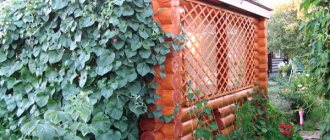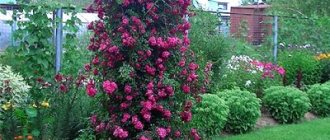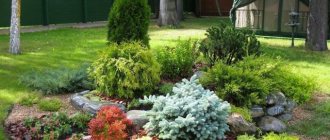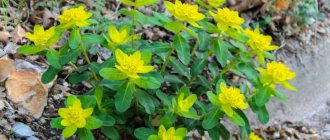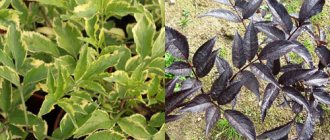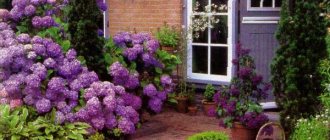Zefirka
> Useful > Climbing plants for vertical gardening of buildings
The advantage of using climbing plants for landscaping is that with a relatively small depth of the green wall, you can plant large spaces in height and width. Plants used in vertical gardening grow quickly and therefore can be used to green various objects in a short time.
Vertical gardening is used when decorating various buildings, stone walls and steep slopes, gazebos, pergolas, etc. When landscaping buildings, climbing plants are placed along the walls, attached directly to the wall or placed on special supports. Landscaping of buildings also involves placing plants on balconies and in window openings.
Winter-hardy climbing plant species
Climbing rose. The climbing queen of flowers, despite its external fragility and sophistication, withstands frost. But you need to be prepared for the fact that a luxurious shrub requires special care. Carefully tied shoots will ensure the plant grows up to 5 meters in height.
7f9b39a5965a59e7b4f14543c766aab7.jpe 8c4b151339b1b41db5dea80ae80539aa.jpe

95c97c81485f2bcdffcba4cdf21ebb7e.jpe
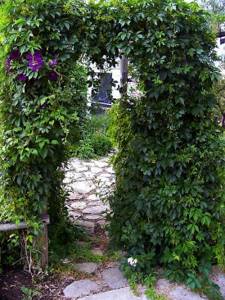
07a7f84b87754aae17dcf4e387261b7c.jpe

afbfa2db5b59568be3e42378a8bd02ca.jpe
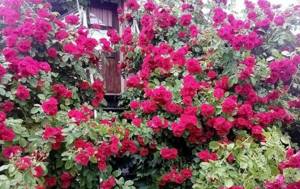
Euonymus. A plant with poisonous fruits, but the bright green color of the large leaves looks very impressive. It needs shaping and regular pruning; it can withstand frost down to -35 degrees. Euonymus prefers moisture and shady places.
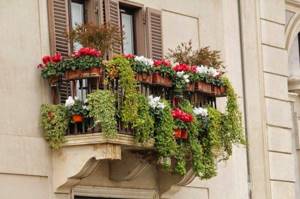
Kampsis. A spreading vine with orange oblong flowers without shelter can withstand frost down to -20 degrees. Campsis grows equally quickly both in the sun and in the shade, flowering begins in the third year after planting, and lasts from mid-summer to the end of October.
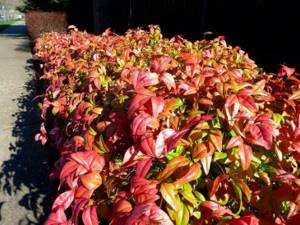
Schisandra chinensis. By regularly feeding and watering the plant, which must be planted in the shade, you can grow it up to 15 meters high.
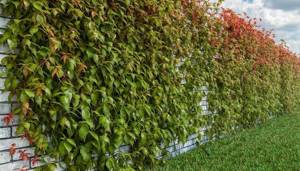
Does not require insulation; the intensive growth phase begins in the second year of planting. You can perfectly shade a gazebo with lemongrass; its fruits exude an indescribable citrus aroma.
Natural fencing is the ideal eco-friendly solution for adding an aesthetic touch to a gazebo, hedge or terrace.
Even residents of the north can afford to grow a luxurious hedge without worrying about how a properly selected plant will survive the cold period. As for residents of regions with milder climates, they can change plants every year or give preference to an annual favorite.
Top Climbing Plants for Home Decor
climbing roses
Climbing roses are real queens among fast climbing plants for a gazebo. All summer long, lush flowers decorate the garden. There are many re-blooming modern varieties. Roses love warmth and a lot of light. Place the gazebo directly under the sun and then the blooming garden will become your source of inspiration!
Gardeners are pleased with the climbing rose due to its unpretentiousness. Good watering and fertilizers are the whole secret of caring for the plant. One of the most popular types is New Dawn. It quickly grows throughout the gazebo and delights the owners with pale pink flowers. The variety is winter-hardy, but in frosty weather it is better to cover the flowers. New Dawn grows evenly in width and height, creating a unique atmosphere in the garden.
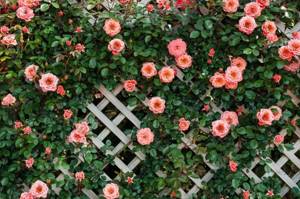
Climbing roses.
Wisteria
A flowering tree has a dense trunk, but this does not prevent it from decorating, for example, the roof over the porch of a house. The plant blooms profusely and is not difficult to care for. Wisteria needs frequent watering only in the first year, and then in extreme heat. Experienced gardeners recommend mulching the plant and sometimes adding compost.
Among climbing plants for a gazebo, Wisteria can be called fast-growing and perennial, but not winter-hardy. If the plant survives the frosts during its first winter, it will produce new shoots in the spring.
Wisteria (another name) grows by twisting, but this must be strictly monitored. The plant looks much more beautiful if you let it spread its shoots to the sides. To do this, you need to direct them in the right direction in time. If this is not done, Wisteria may suffocate itself or damage your home decor. With proper care, wood creates a unique atmosphere.

Wisteria.
Clematis
Climbing plants for a gazebo are often chosen for photos. Their best titles are searched all over the Internet. Clematis (the Buttercup family) is always found in the top queries of search engines.
The fast-growing vine can grow up to 3 meters, so it needs strong support. The plant has no petals, only individual cups of 4-7 leaves, painted in different colors. Clematis stand out from the climbing ones in that they produce an unprecedented number of shoots. The more there are, the more abundant the flowering will be. With proper deep planting, the plant grows more and more every year and produces lush flowering, creating a real flower paradise in the garden!
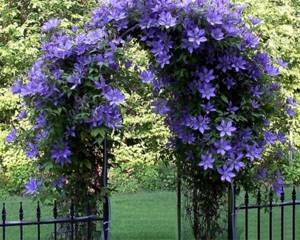
Clematis.
Akebia
The plant is often called chocolate vine. In the East it can grow up to 12 meters, but in our harsh climate Akebia grows smaller in size. There are 2 types of Akebia: quintuple and trifoliate. It is quite simple to distinguish them: the first leaves on the stalk are actually arranged in the shape of a five at the same distance from each other. Akebia trifoliata grows up to 25 meters and in the fall pleases with blue lavender colored fruits.
b68ad19485c9ad5dd61f64f6ba955315.jpe

b3d972016122cb3957285ec2ecced228.jpe
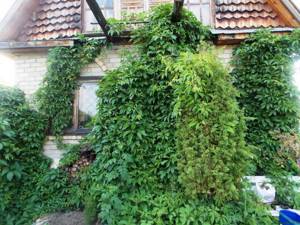
The plant was nicknamed chocolate vine for its spicy aroma, reminiscent of sweetness. This is not its only advantage. An unpretentious plant to care for, it requires fertilization with compost at the initial stage.
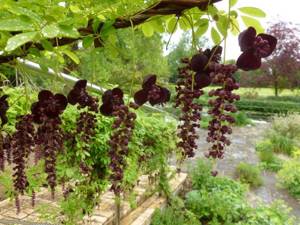
Prince
The plant is suitable for those gardeners who want to make a gazebo out of climbing plants with their own hands. Here you definitely won’t need the advice of experienced gardeners, because Knyazhik is one of the most unpretentious vines to care for. In country houses it is often planted to cover an unsightly wall or to create a “hedge”.
Prince.
Climbing Prince is loved in Russia for its excellent winter hardiness. Its flowering can only be seen on last year's shoots and occurs in May-June. Prince's flowers come in simple and double flowers of any shade: white, blue, pink, etc. Many consider the plant to be elegant and call it a “gardener’s classic.” When planting a plant, you don’t have to worry about low temperatures. Your efforts will definitely pay off with many years of flowering!
The most popular varieties according to reviews from summer residents
Ivy
It is often seen on the walls of ancient castles and fortresses. Not surprising! A small seedling quickly turns into a powerful evergreen vine. It spreads quickly; when decorating, it is necessary to control its growth. It braids well on both horizontal and vertical surfaces due to its small aerial roots, with which it sticks firmly even to stone. Not suitable for painted surfaces, because You can only remove the plant with a thick layer of paint. If the gazebo is located in the sunny part of the garden plot, it is the ivy that will provide continuous shade in it
Another little-known but important property of ivy is its fire resistance. The plant does not ignite easily
The close location of the barbecue will not harm him much.

Ivy.
Five-leaved maiden grape
Fast-growing climbing plants for decorating a gazebo are not uncommon, but maidenhair grapes are the champion among them. One plant reaches 20-30 meters in length. The variety is widespread throughout the world. The plant is frost-resistant and completely unpretentious in care. A gazebo braided with it will be beautiful from the beginning of summer until mid-autumn. In June, large bright green leaves appear; the flowering of the grapes is unattractive, but does not spoil the overall picture. For many summer residents, it is during the golden autumn that Devichy Grapes acquires its aesthetic value. The color palette of foliage varies from light yellow in the shade to bright red, even crimson in the sun. Dark blue, almost black fruits will ripen by early September. By combining tree pliers, which acquire a delicate golden color in the fall, and maiden grapes on your site, you will create a beautiful area for photo and video shooting from climbing plants and your gazebo. Guests and family will be very grateful to you for this!

Five-leaved maiden grape.
Common hop
Common hops are ideal for lovers of homemade bread and beer producers! For decorating a gazebo, it’s beautiful and useful, because... The plant is also medicinal. In Russia it is widespread, with the only exceptions being the Far North and Altai. The root system of hops is strong, grows quickly and reaches 7 meters. For planting, it is better to choose partial shade, although it feels comfortable in the sun and grows very thickly. Prefers clay soil fertilized with humus.
Hops look neat and beautiful during the flowering period. Its soft light green cones are grouped side by side and stand out with bright strokes against the background of green leaves. As they ripen and dry, they acquire a pleasant golden color.
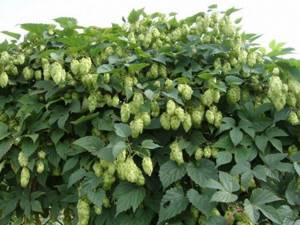
Common hops.
Morning glory blue
Among the popular annual climbing plants for gazebos, the name “morning glory” is found. The most famous plant is the blue morning glory. It finds support on its own and begins to wrap powerful shoots around it. Plants can spread over an area of about five square meters, which is enough to decorate one wall of a small gazebo. It is propagated by seeds that fall out of the pods and will produce young shoots the following year. Conventionally, morning glory can be called a perennial plant, because once planted in a certain place, it will continue to grow from seeds for many years.
836c914f8e452874e4451e67a4c8cef7.jpe
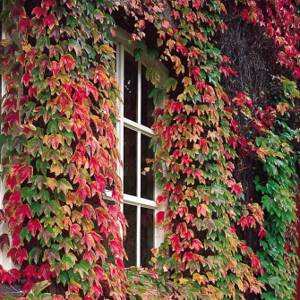
5c9afa9746b14a2ded1cf6e7a28bd302.jpe

63434f3dac7271cbdb0b05d201c06bab.jpe
In the cool morning hours, delicate blue gramophone flowers (up to 10 cm in diameter) open. Closer to lunch, the flower closes - it does not like direct sunlight. If there are clouds in the sky, morning glory will bloom all day long.
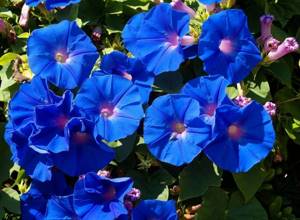
Morning glory blue.
Campsis or Tecoma
A perennial liana, without which it is difficult to imagine at least one summer cottage. The arbor, in the composition of which the tekoma is involved, stands out against the greenery of the garden with bright orange flowers up to 8 cm in diameter, similar to decorative bells, collected in inflorescences. Often such flowers attract little princesses, and they are happy to make ball gowns for their flower dolls. There are two types of this beautiful plant: large-flowered and rooting. Both are frost-resistant and have a strong root system (if the upper part freezes out, this vine will recover fairly quickly). Easily tolerates short-term frosts up to 18° C. For the winter, the vines should be removed from the supports, laid on the ground and sprinkled.

Campsis or tekoma.
Schisandra chinensis
A plant for decorating a gazebo and delicious, healthy tea. Frost-resistant lemongrass is unpretentious to lighting; it is better to plant it in shaded places. In the first two years after sowing the seeds, it grows slowly, then quickly grows, turning into a wonderful climbing plant with beautiful green foliage. During the flowering period, lemongrass exudes a subtle aroma. In autumn, lemongrass will delight you with bright red fruits!

Schisandra chinensis.
Rules for planting climbing green plants near a pergola
Various types and varieties of decorative vines can be used as climbing vegetation for pergolas. But when planting them next to structures, many make unforgivable mistakes that could have been avoided. What should not be done when vertical gardening of a small architectural form?
- First of all, you should not plant climbing plants with different periods of growth and development near the pergola. Such a difference will not allow you to create a beautiful hedge.
- You should not choose a large number of types of vines for landscaping the structure. Excessive variety can make caring for them much more difficult. In this case, the pergola will look colorful and stand out from the overall design concept of the garden plot.
- We must not neglect the resistance of the plants that will cover your pergola or gazebo to the climatic conditions of your strip. In harsh years, some varieties may lose their attractiveness as a result of freezing.
Taking these errors into account, the following landing rules can be concluded:
- Choose no more than 2…3 types of plants for the pergola. It is best if these are vines of one or two types.
- Select plants with similar periods of development and growth.
- Plant only varieties and types of climbing vines that are adapted and resistant to your climatic conditions.
Perennial climbing plants - what to choose?
Today there are many types of perennials that can be planted in the country. Here are some types of shrubs that can be planted near the gazebo:
- tree-like and herbaceous. They differ from each other in that in the former the plantings grow annually, while in the latter the above-ground part dies off in the fall and grows back in the spring;
- frost-resistant and heat-loving. Some can overwinter without additional shelter, while others need mulching or insulation of the ground part.
To decorate the gazebo, the following perennials are often planted:
Sea anemone colominta. It is an ornamental fruit shrub with vine-like shoots, the length of which can reach up to 15 meters. The change in leaf color throughout the season is especially impressive. The initial light green color gives way to white, which turns into a yellow, pinkish, crimson hue. In addition, flowers spread a pleasant aroma around themselves. In autumn, berries appear that are similar in taste to gooseberries and are rich in vitamin C.
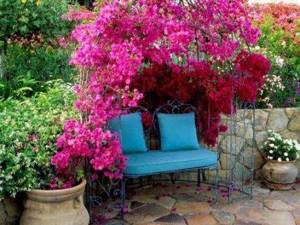
Vineyard is a vine crop growing in North America and Asia. In Russia, only two species out of twenty are cultivated. Short-peduncle (Ussuri) is common in the Primorsky Territory and the western regions of the country. Aconitofolia, cultivated in central Russia and the southern regions. The contrast of leaves and berries gives the plant a decorative appearance. With the onset of summer, the berries stand out against the background of green leaves, and closer to autumn, the fruits acquire a bluish color and the foliage becomes red. But the berries are not edible.

Honeysuckle is an unpretentious perennial that easily tolerates crown pruning and its formation. Over the summer it grows up to five meters. It blooms with fragrant flowers, which are an excellent honey plant. In some varieties, the berries can be eaten.
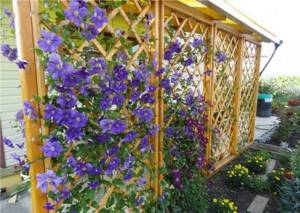
962f6838d5b4d144d9458f8ead6f6803.jpe
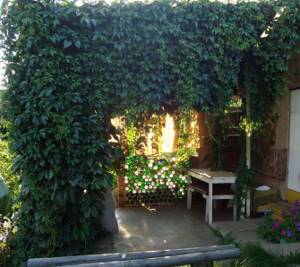
efe9374067b7a004962a85ec84d1e6d6.jpe

Clematis is a perennial flowering vine with flowers of various shades. Clematis blooms for almost three months, and very profusely. The plant looks most impressive if planted in a sunny area. For an original decoration of the gazebo, you can use clematis of various varieties, harmonizing in color.

Climbing roses do not leave anyone indifferent. Currently, they are actively used to decorate summer cottages. Many varieties of roses have been bred. They differ in the shape and color of the buds, and the timing of flowering. Their shoots can grow up to 15 meters in height. Climbing roses with flexible shoots - ramblers - are especially popular. They bloom magnificently and for a long time until late autumn, they are not afraid of frost, and some varieties have a rich aroma.
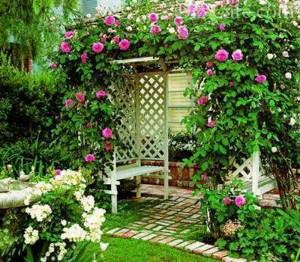
Wisteria is a plant that beautifully entwines any structure or arch and is perfect for decorating a summer cottage. Wisteria flowers have different colors - purple, yellow, white.

In addition to these plants, a wonderful decoration for the gazebo is unpretentious green ivy, which entwines any supports, Chinese lemongrass with a citrus aroma, and replaces green summer foliage with yellow-orange foliage in autumn.

Climbing plants for a gazebo, perennials, not only decorate the gazebo, but also help it blend organically into the surrounding landscape and hide existing defects and unsightly places. In addition, by weaving around the gazebo, they create natural coolness and shading, and protect from wind and raindrops. Also, growing such plants does not require a large area; many perennials are not picky about soil. The exception is clematis, climbing roses, which form weak flowering on dry and poor soil.


